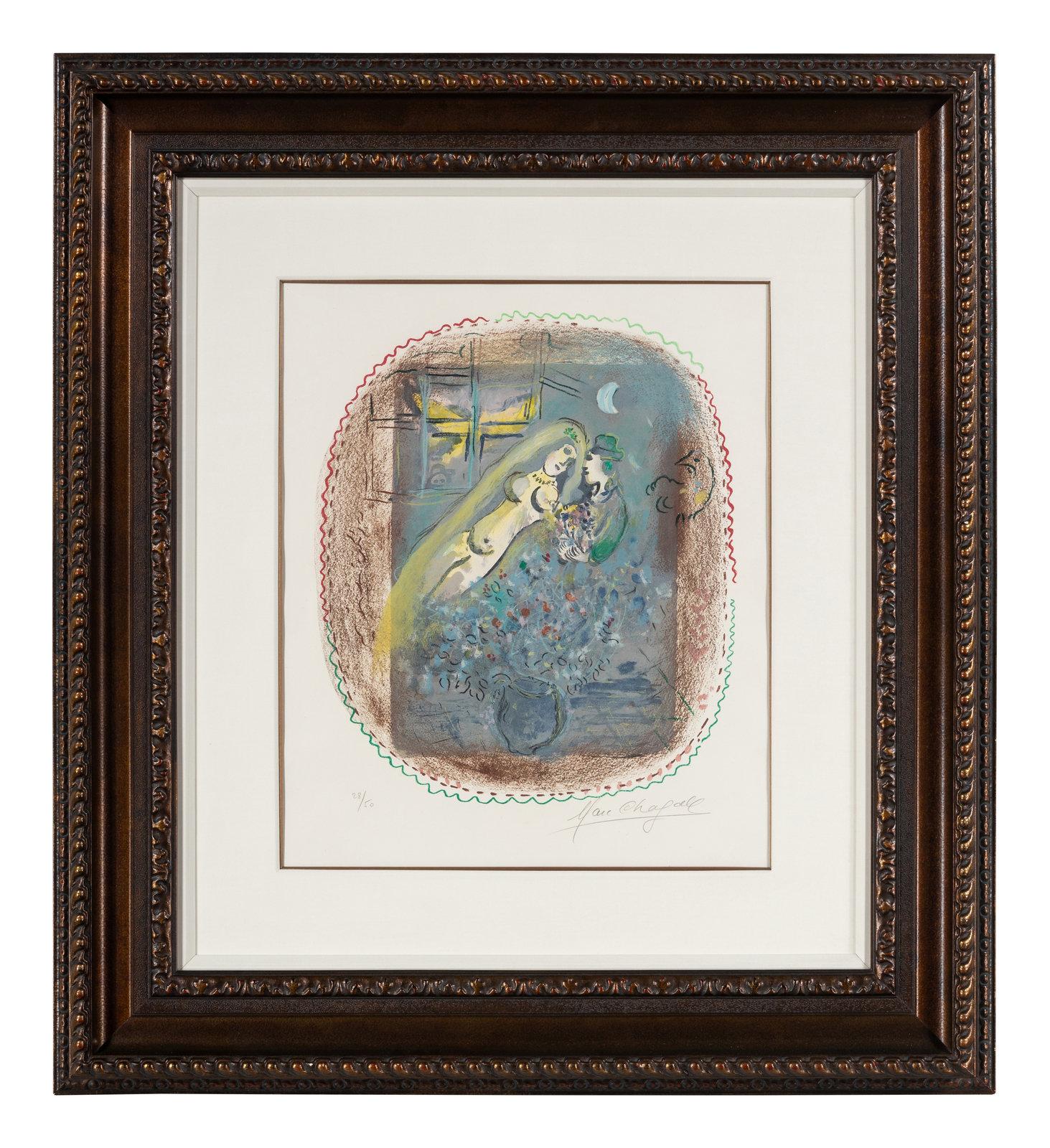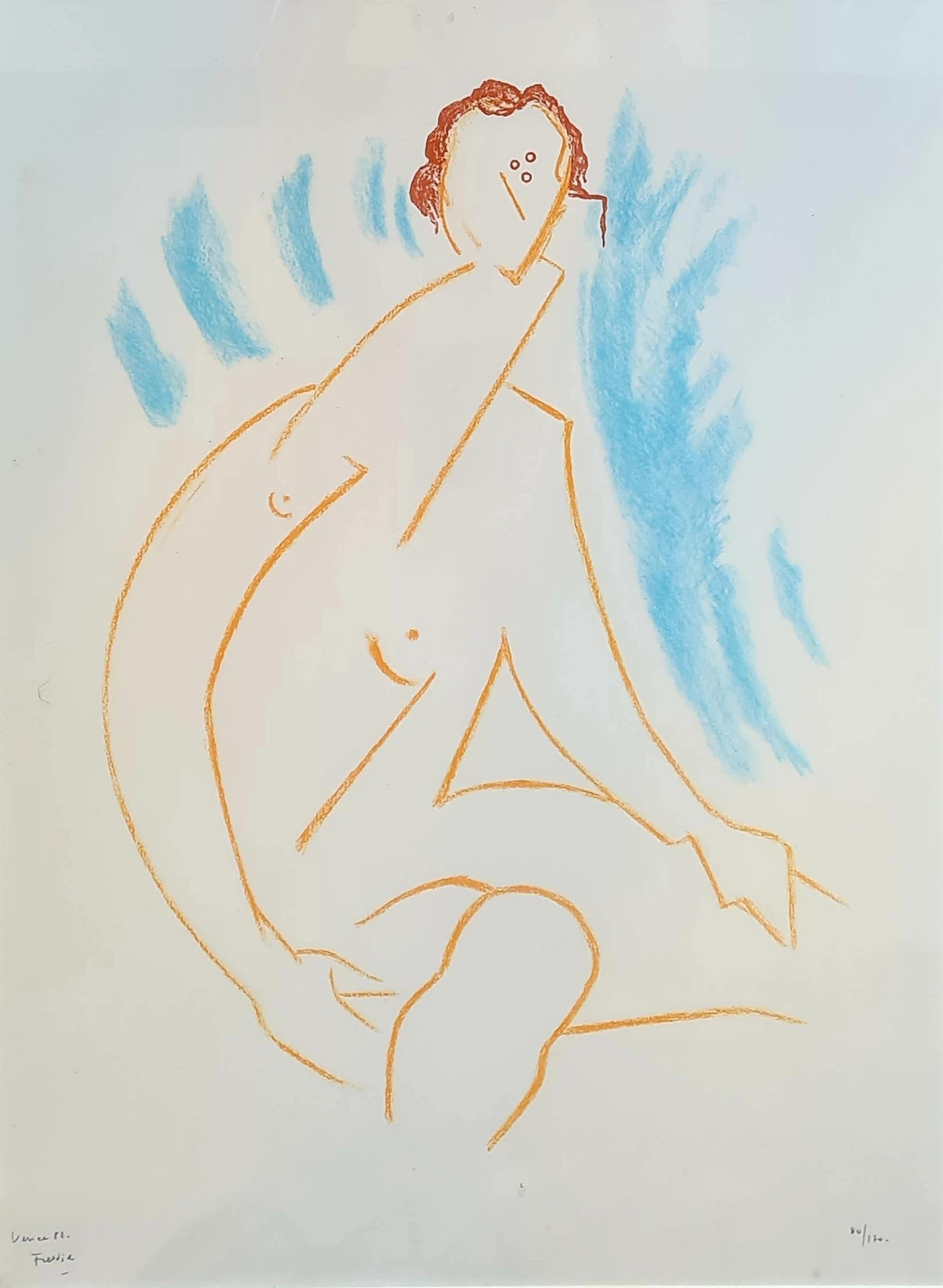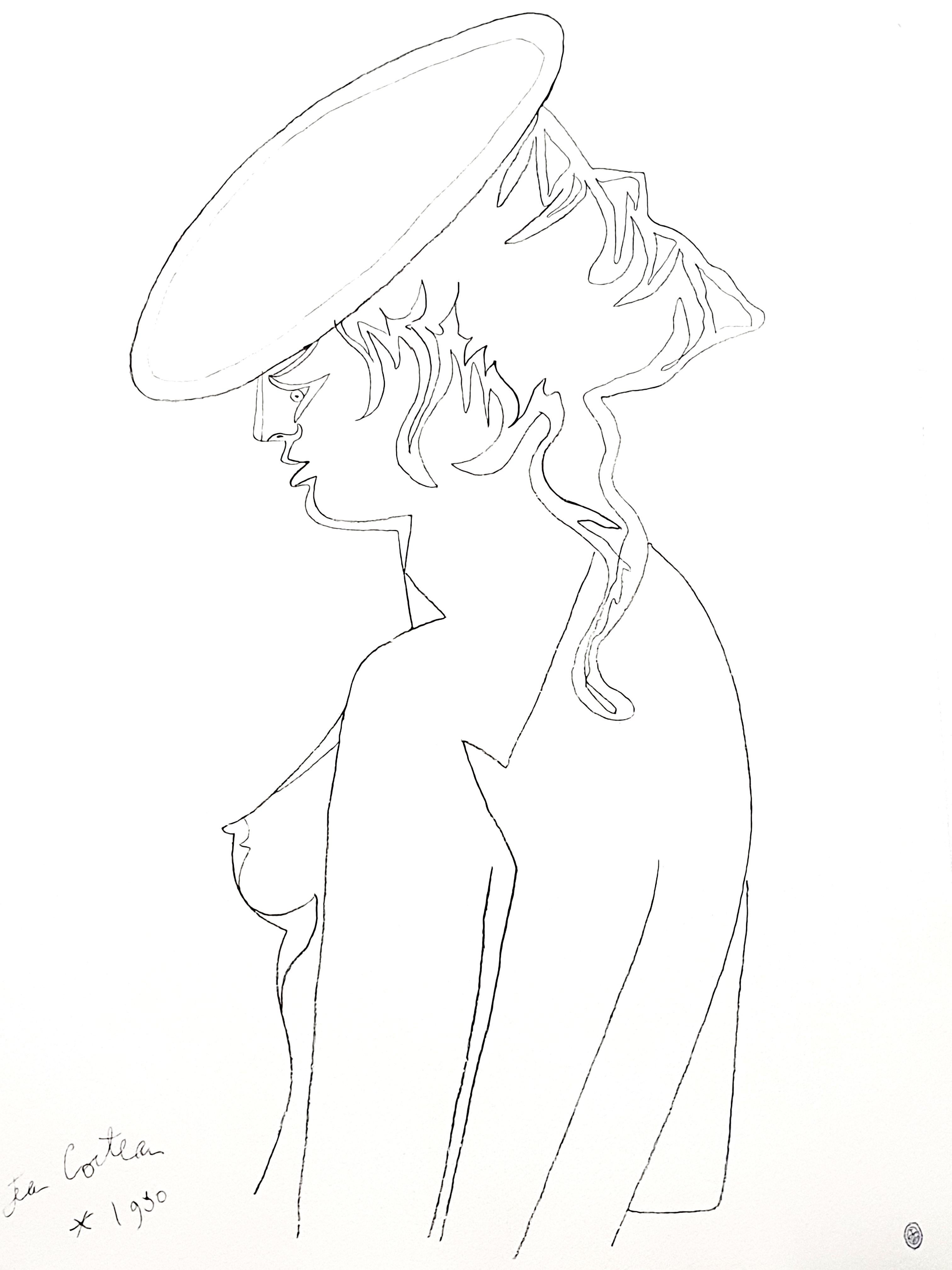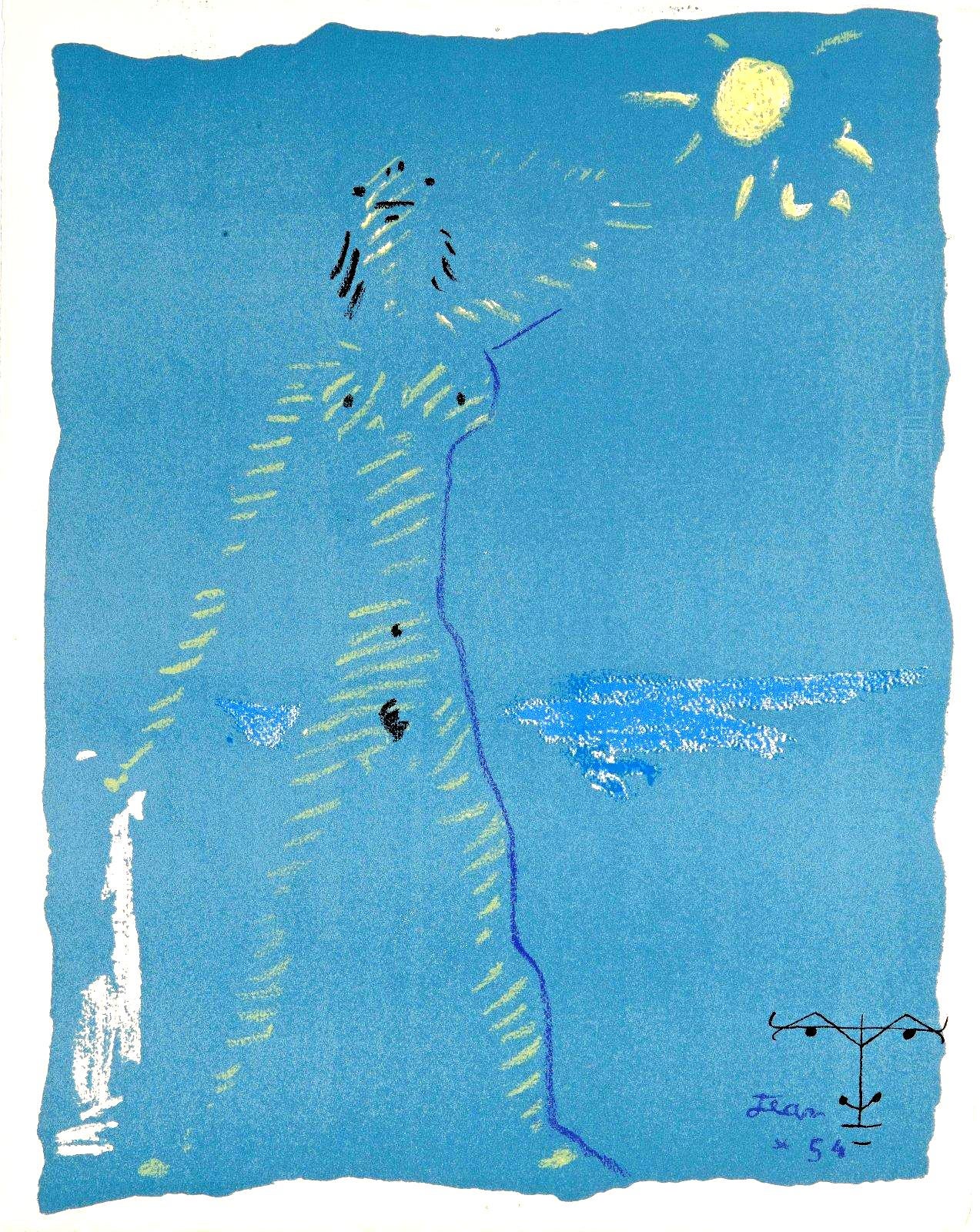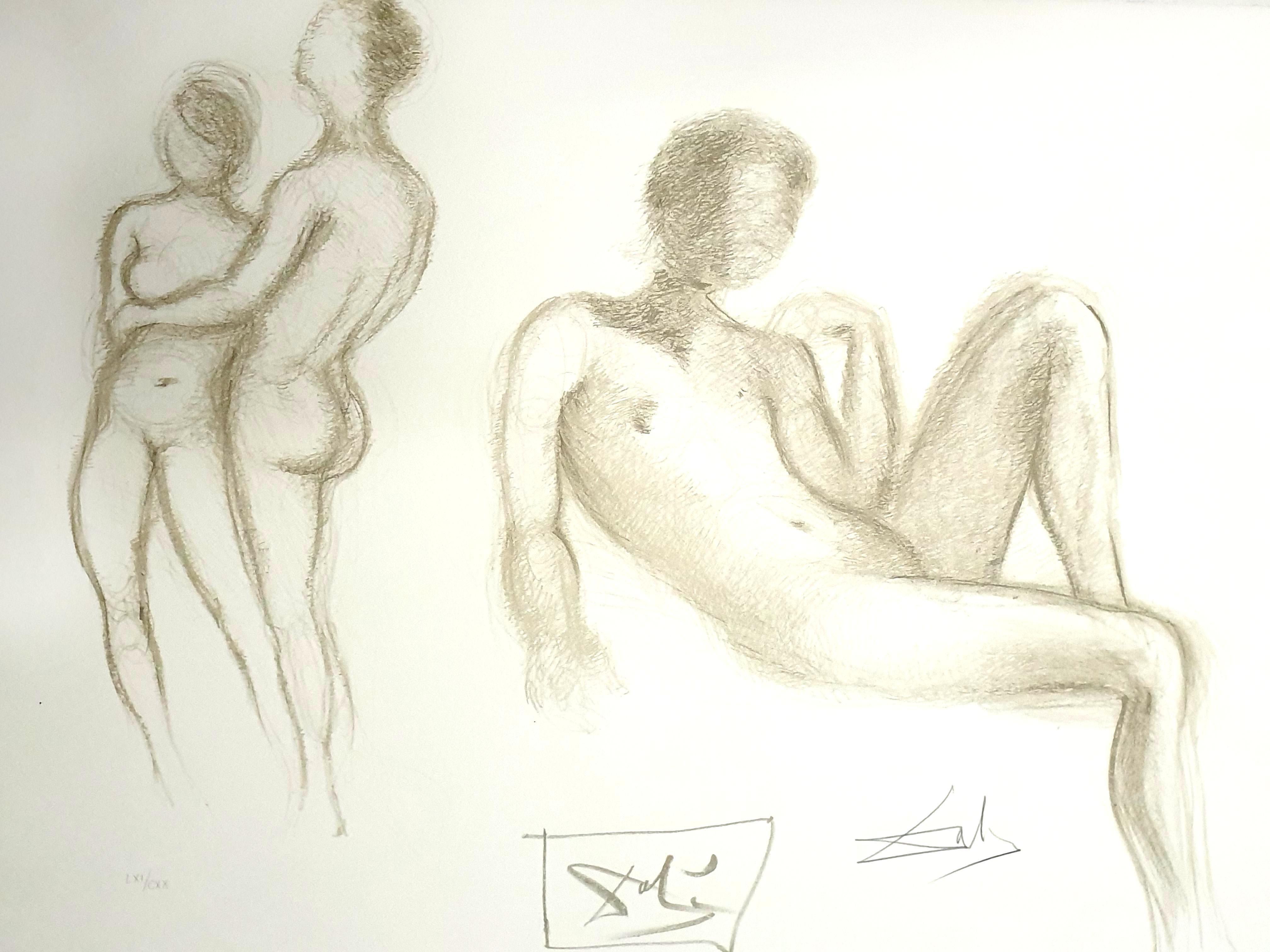Items Similar to Une Jeune Femme Presente Avec Grace, from Les Enfants Trouves
Want more images or videos?
Request additional images or videos from the seller
1 of 11
(after) René MagritteUne Jeune Femme Presente Avec Grace, from Les Enfants Trouves1953, published 1968
1953, published 1968
About the Item
This artwork titled "" Une Jeune Femme Presente Avec Grace" from the suite" Les Enfants Trouves created in 1953 and printed/published in 1968 in an edition of 350. This artwork come from the edition numbered 239/350 on the colophon of the suite. It is a color lithograph on paper by renown Belgian artist, Rene Magritte 1898-1967. It is signed in the stone by the artist and signed in pencil at the lower right corner by the printer, Fernand Mourlot. Published by A.C Mazo, Paris, France and printed by Fernand Mourlot, Paris, France. The image size is 12.5 x 17.75 inches, sheet size is 17.5 23.5 inches, framed size is 24.5 x 28.75 inches. Framed in a custom wooden gold frame, with fabric matting and gold color spacer. It is in excellent condition.
About the artist.
Rene Magritte was born on the 21st November, 1898 in Hainaut, Belgium. His father was a tailor and a merchant. As his business did not go well the family had to move often. René lost his mother early and tragically - she committed suicide for unclear reasons. René was only 14 years old at the time.
From 1916 through 1918 Magritte studied in the Royal Academy of Arts in Brussels (Académie Royale des Beaux-Arts). He became a wallpaper designer and commercial artist. His early painting works were executed under the influence of the Cubism and Futurism (1918-20), then he was inspired by the Purists and Fernand Léger. In 1922 Magritte married Georgette Berger, with whom he first became acquainted when fifteen years old. After meeting again in 1920, she became his model and then wife.
The friendship with Giorgio de Chirico's and Dadaistic poetry constituted an important artistic turning-point for Magritte. In 1925 he came close with a group of Dadaists and co-operated in the magazines Aesophage and Marie, together with E.L.T. Mesens, Jean Arp, Francis Picabia, Schwitters, Tzara and Man Ray.
In 1926 Magritte painted The Lost Jockey, it is his first painting that he allowed to be labeled as "Surrealist". After his first, badly-received, one-man show in Brussels in 1927, he left for Paris. In 1927-30 Magritte lived in France, where he participated in the activities of the Surrealists, establishing a close friendship in particular with Max Ernst, Dali, André Breton and especially with Paul Eluard.
In Paris, Magritte's system of conceptual painting was formed, it remained almost unchanged until the end of his life.
Demonstrating the problems of visual perception and illusionary of images, Magritte used the symbols of mirrors, eyes, windows, stages and curtains and pictures within pictures (The False Mirror, 1935, The Key to the Fields. 1936, Beautiful World. 1962.)
In the 1950s Magritte executed two fresco cycles: The Enchanted Realm for a casino in Knokke-le-Zut (1953) and The Ignorant Fairy (1957) for the Palais des Beaux-Arts in Charleroi. These monumental compositions repeat the motifs of his previous paintings. In his last year Magritte began to make sculptures of his painted images. Rene Magritte’s work is held in numerous major museums and collections worldwide. Magritte died of pancreatic cancer on 15 August 1967, and was interred in Schaerbeek Cemetery, Evere, Brussels.
- Creator:(after) René Magritte (1898 - 1967, Belgian)
- Creation Year:1953, published 1968
- Dimensions:Height: 24.5 in (62.23 cm)Width: 28.75 in (73.03 cm)Depth: 1.35 in (3.43 cm)
- Medium:
- Movement & Style:
- Period:
- Condition:
- Gallery Location:San Francisco, CA
- Reference Number:
About the Seller
5.0
Platinum Seller
These expertly vetted sellers are 1stDibs' most experienced sellers and are rated highest by our customers.
Established in 1999
1stDibs seller since 2017
681 sales on 1stDibs
Typical response time: 1 hour
- ShippingRetrieving quote...Ships From: San Francisco, CA
- Return PolicyA return for this item may be initiated within 7 days of delivery.
More From This SellerView All
- UntitledBy Théophile Alexandre SteinlenLocated in San Francisco, CAArtist: Theophile Alexandre Steinlen (Swiss, 1859-1923) Title: Untitled Year: c.1915 Medium: Lithograph Edition: Unknown, probably 400 Paper: Thin vellum Image size: 1...Category
Early 20th Century Realist Figurative Prints
MaterialsLithograph
- Torso de Joven (Torso de Jeune Fille)By Rufino TamayoLocated in San Francisco, CAThis artwork titled "Torso de Joven (Torso de Jeune Fille)" from the suite "The Mujeres File" 1969 is an original colors lithograph on Wove paper by renown Mexican artist Rufino Tama...Category
Mid-20th Century Modern Figurative Prints
MaterialsLithograph
- Torso de MujerBy Rufino TamayoLocated in San Francisco, CAThis artwork titled "Torso de Mujer (Torso de Femmee)" from the suite "The Mujeres File" 1969 is an original colors lithograph on Wove paper by renown Mexican artist Rufino Tamayo, 1899-1991. It is hand signed and inscribed H.C. (Hors Commerce) in pencil by the artist. The image size is 26.85 x 21 inches, framed size is 40.75 x 33 inches. Published by Touchtone Publisher, New York, printed by Ateliers Desjobert, Paris. Referenced and pictured in the artist's catalogue raisonne by Pereda, plate #108 page 107. Custom framed in a wooden gold frame, with gold bevel and light beige fabric matting. It is in excellent condition. About the artist: A native of Oaxaca in Southern Mexico, Rufino Tamayo's father was a shoemaker, and his mother a seamstress. Some accounts state that he was descended from Zapotec Indians, but he was actually 'mestizo' - of mixed indigenous/European ancestry. (Santa Barbara Museum of Art). He began painting at age 11. Orphaned at the age of 12, Tamayo moved to Mexico City, where he was raised by his maternal aunt who owned a wholesale fruit business. In 1917, he entered the San Carlos Academy of Fine Arts, but left soon after to pursue independent study. Four years later, Tamayo was appointed the head designer of the department of ethnographic drawings at the National Museum of Archaeology in Mexico City. There he was surrounded by pre-Colombian objects, an aesthetic inspiration that would play a pivotal role in his life. In his own work, Tamayo integrated the forms and tones of pre-Columbian ceramics...Category
Mid-20th Century Modern Figurative Prints
MaterialsLithograph
- La Negra (The Black Woman)By Rufino TamayoLocated in San Francisco, CAThis artwork titled "La Negra (The Black Woman)" from the suite "The Mujeres File" 1969 is an original colors lithograph on B.F.K. Rives paper by renown Mexican artist Rufino Tamayo, 1899-1991. It is hand signed and numbered 150/150 in pencil by the artist. The image size is 26.85 x 21.25 inches, sheet size is 29.5 x 22.15 inches, framed size is 42 x 35 inches. Published by Touchtone Publisher, New York, printed by Ateliers Desjobert, Paris. Referenced and pictured in the artist's catalogue raisonne by Pereda, plate #109 page 107. Custom framed in a wooden silver frame, with silver spacer and fabric matting. It is in excellent condition. About the artist: A native of Oaxaca in Southern Mexico, Rufino Tamayo's father was a shoemaker, and his mother a seamstress. Some accounts state that he was descended from Zapotec Indians, but he was actually 'mestizo' - of mixed indigenous/European ancestry. (Santa Barbara Museum of Art). He began painting at age 11. Orphaned at the age of 12, Tamayo moved to Mexico City, where he was raised by his maternal aunt who owned a wholesale fruit business. In 1917, he entered the San Carlos Academy of Fine Arts, but left soon after to pursue independent study. Four years later, Tamayo was appointed the head designer of the department of ethnographic drawings at the National Museum of Archaeology in Mexico City. There he was surrounded by pre-Colombian objects, an aesthetic inspiration that would play a pivotal role in his life. In his own work, Tamayo integrated the forms and tones of pre-Columbian ceramics into his early still lives and portraits of Mexican men and women. In the early 1920s he also taught art classes in Mexico City's public schools. Despite his involvement in Mexican history, he did not subscribe to the idea of art as nationalistic propaganda. Modern Mexican art at that time was dominated by 'The Three Great Ones' : Diego Rivera, Jose Clemente Orozco, and David Alfaro Siqueros, but Tamayo began to be noted as someone 'new' and different' for his blending of the aesthetics of post Revolutionary Mexico with the vanguard artists of Europe and the United States. After the Mexican Revolution, he focused on creating his own identity in his work, expressing what he thought was the traditional Mexico, and refusing to follow the political trends of his contemporary artists. This caused some to see him as a 'traitor' to the political cause, and he felt it difficult to freely express himself in his art. As a result, he decided to leave Mexico in 1926 and move to New York, along with his friend, the composer Carlos Chavez. The first exhibition of Tamayo's work in the United States was held at the Weyhe Gallery, New York, in that same year. The show was successful, and Tamayo was praised for his 'authentic' status as a Mexican of 'indigenous heritage', and for his internationally appealing Modernist aesthetic. (Santa Barbara Museum of Art). Throughout the late thirties and early forties New York's Valentine Gallery gave him shows. For nine years, beginning in 1938, he taught at the Dalton School in New York. In 1929, some health problems led him to return to Mexico for treatment. While there he took a series of teaching jobs. During this period he became romantically involved with the artist Maria Izquierdo...Category
Mid-20th Century Modern Figurative Prints
MaterialsLithograph
- Singing in the Bath, Tenakee SpringsLocated in San Francisco, CAThis artwork titled "Singing in the Bath, Tenakee Springs" 1996 is a color offset lithograph on paper by noted American artist Rie Mounier Munoz, 1921-2015. It is hand signed and numbered 1077/1100 in pencil by the artist. The image size is 13.5 x 10 inches, sheet size is 16 x 12.35 inches. It is in excellent condition, has never been framed. About the artist: Alaska painter Rie Mounier Munoz was the child of Dutch parents who immigrated to California, where she was born and raised. She is known for her colorful scenes of everyday life in Alaska. Rie (from Marie) Munoz (moo nyos), studied art at Washington and Lee University in Virginia. In 1950, she traveled up the Inside Passage by steamship, fell in love with Juneau, and gave herself until the boat left the next day to find a job and a place to live. Since then Juneau has been home to Munoz. She began painting small vignettes of Alaska soon after arriving in Juneau, and also studied art at the University of Alaska-Juneau. Munoz painted in oils in what she describes as a "painstakingly realistic" style, which she found stiff and "somewhat boring." Her breakthrough came a few years later when an artist friend introduced her to a versatile, water-soluble paint called casein. The immediacy of this inexpensive medium prompted an entirely new style. Rie's paintings became colorful and carefree, mirroring her own optimistic attitude toward life. With her newfound technique she set about recording everyday scenes of Alaskans at work and at play. Of the many jobs she has held journalist, teacher, museum curator, artist, mother, Munoz recalls one of her most memorable was as a teacher on King Island in 1951, where she taught 25 Eskimo children. The island was a 13-hour umiak (a walrus skin boat) voyage from Nome, an experience she remembers vividly. After teaching in the Inupiat Eskimo village on the island with her husband during one school year, she felt a special affinity for Alaska's Native peoples and deliberately set about recording their traditional lifestyles that she knew to be changing very fast. For the next twenty years, Rie practiced her art as a "Sunday painter," in and around prospecting with her husband, raising a son, and working as a freelance commercial artist, illustrator, cartoonist, and curator of exhibits for the Alaska State Museum. During her years in Alaska, Munoz has lived in a variety of small Alaskan communities, including prospecting and mining camps. Her paintings reflect an interest in the day-to-day activities of village life such as fishing, berry picking, children at play, as well as her love of folklore and legends. Munoz says that what has appealed to her most were "images you might not think an artist would want to paint," such as people butchering crab, skinning a seal, or doing their laundry in a hand-cranked washing machine. In 1972, with her hand-cut stencil and serigraph prints selling well in four locations in Alaska, she felt confident enough to leave her job at the Alaska State Museum and devote herself full time to her art. Freed from the constraints of an office job, she began to produce close to a hundred paintings a year, in addition to stone lithograph and serigraph prints. From her earliest days as an artist, Rie had firm beliefs about selling her work. First, she insisted the edition size should be kept modest. When she decided in 1973 to reproduce Eskimo Story Teller as an offset lithography print and found the minimum print run to be 500, she destroyed 200 of the prints. She did the same with King Island, her second reproduction. Reluctantly, to meet market demand, she increased the edition size of the reproductions to 500 and then 750. The editions stayed at that level for almost ten years before climbing to 950 and 1250. Her work has been exhibited many solo watercolor exhibits in Alaska, Oregon and Washington State, including the Charles and Emma Frye Art Museum, Alaska State Museum in Juneau, Anchorage Historical and Fine Arts Museum, Tongass Historical Museum in Ketchikan, and Yukon Regional Library in Whitehorse; Yukon Territory, and included in exhibits at the Smithsonian Institute and Russell Senate Office Building in Washington, D.C. Munozs paintings have graced the covers of countless publications, from cookbooks to mail order catalogs, and been published in magazines, newspapers, posters, calendars, and two previous collections of her work: Rie Munoz...Category
Late 20th Century Folk Art Nude Prints
MaterialsLithograph
- Steam Bath, AniakLocated in San Francisco, CAThis artwork titled "Steam Bath, Aniak" 1995 is a color offset lithograph on paper by noted American artist Rie Mounier Munoz, 1921-2015. It is hand signed and numbered 38/950 in pencil by the artist. The image size is 6.75 x 10 inches, sheet size is 10.5 x 14 inches. It is in excellent condition.. About the artist: Alaska painter Rie Mounier Munoz was the child of Dutch parents who immigrated to California, where she was born and raised. She is known for her colorful scenes of everyday life in Alaska. Rie (from Marie) Munoz (moo nyos), studied art at Washington and Lee University in Virginia. In 1950, she traveled up the Inside Passage by steamship, fell in love with Juneau, and gave herself until the boat left the next day to find a job and a place to live. Since then Juneau has been home to Munoz. She began painting small vignettes of Alaska soon after arriving in Juneau, and also studied art at the University of Alaska-Juneau. Munoz painted in oils in what she describes as a "painstakingly realistic" style, which she found stiff and "somewhat boring." Her breakthrough came a few years later when an artist friend introduced her to a versatile, water-soluble paint called casein. The immediacy of this inexpensive medium prompted an entirely new style. Rie's paintings became colorful and carefree, mirroring her own optimistic attitude toward life. With her newfound technique she set about recording everyday scenes of Alaskans at work and at play. Of the many jobs she has held journalist, teacher, museum curator, artist, mother, Munoz recalls one of her most memorable was as a teacher on King Island in 1951, where she taught 25 Eskimo children. The island was a 13-hour umiak (a walrus skin boat) voyage from Nome, an experience she remembers vividly. After teaching in the Inupiat Eskimo village on the island with her husband during one school year, she felt a special affinity for Alaska's Native peoples and deliberately set about recording their traditional lifestyles that she knew to be changing very fast. For the next twenty years, Rie practiced her art as a "Sunday painter," in and around prospecting with her husband, raising a son, and working as a freelance commercial artist, illustrator, cartoonist, and curator of exhibits for the Alaska State Museum. During her years in Alaska, Munoz has lived in a variety of small Alaskan communities, including prospecting and mining camps. Her paintings reflect an interest in the day-to-day activities of village life such as fishing, berry picking, children at play, as well as her love of folklore and legends. Munoz says that what has appealed to her most were "images you might not think an artist would want to paint," such as people butchering crab, skinning a seal, or doing their laundry in a hand-cranked washing machine. In 1972, with her hand-cut stencil and serigraph prints selling well in four locations in Alaska, she felt confident enough to leave her job at the Alaska State Museum and devote herself full time to her art. Freed from the constraints of an office job, she began to produce close to a hundred paintings a year, in addition to stone lithograph and serigraph prints. From her earliest days as an artist, Rie had firm beliefs about selling her work. First, she insisted the edition size should be kept modest. When she decided in 1973 to reproduce Eskimo Story Teller as an offset lithography print and found the minimum print run to be 500, she destroyed 200 of the prints. She did the same with King Island, her second reproduction. Reluctantly, to meet market demand, she increased the edition size of the reproductions to 500 and then 750. The editions stayed at that level for almost ten years before climbing to 950 and 1250. Her work has been exhibited many solo watercolor exhibits in Alaska, Oregon and Washington State, including the Charles and Emma Frye Art Museum, Alaska State Museum in Juneau, Anchorage Historical and Fine Arts Museum, Tongass Historical Museum in Ketchikan, and Yukon Regional Library in Whitehorse; Yukon Territory, and included in exhibits at the Smithsonian Institute and Russell Senate Office Building in Washington, D.C. Munozs paintings have graced the covers of countless publications, from cookbooks to mail order catalogs, and been published in magazines, newspapers, posters, calendars, and two previous collections of her work: Rie Munoz...Category
Late 20th Century Folk Art Nude Prints
MaterialsLithograph
You May Also Like
- Marc Chagall "Dédicace"By Marc ChagallLocated in Los Angeles, CAMarc Chagall (French/Russian, 1887-1985) "Dédicace" 1968 Color lithograph signed and numbered 28/50 in pencil Image: 17 7/8 x 15 1/4 inches. Framed: 38 x 34 1/4 x 2 1/4 inches. ...Category
Mid-19th Century Surrealist Figurative Prints
MaterialsLithograph
- Avant Garde Surrealist Abstract Female Nude Signed Limited Edition LithographBy Wilhelm FreddieLocated in Cotignac, FRAvant-garde female nude lithograph on paper by Danish artist Wilhelm Freddie. Number 80 from an edition of 170. Signed, dated and titled in pencil bottom left, numbered in pencil bot...Category
Late 20th Century Surrealist Figurative Prints
MaterialsLithograph, Paper
- Three women. 9/50., Paper, etching, 23x58 cmBy André FrançoisLocated in Riga, LVThree women. 9/50., Paper, etching, 23x58 cmCategory
1980s Surrealist Figurative Prints
MaterialsPaper, Lithograph
- Jean Cocteau - Woman's Profile - Original LithographBy Jean CocteauLocated in Collonge Bellerive, Geneve, CHOriginal Lithograph by Jean Cocteau Title: Profil Signed in the plate Dimensions: 65 x 44 cmCategory
1950s Surrealist Figurative Prints
MaterialsLithograph
- Jean Cocteau - Under the Fire Coat - Original LithographBy Jean CocteauLocated in Collonge Bellerive, Geneve, CHJean Cocteau - Under the Fire Coat - Original Lithograph Signed "Jean" in the plate and dated 1954 in the plate. Joseph Forêt Editions Dimensions: 41 x 33 cm...Category
1950s Surrealist Nude Prints
MaterialsLithograph
- Salvador Dali - Nude Couples - LithographBy Salvador DalíLocated in Collonge Bellerive, Geneve, CHSalvador Dali - Nude Couples - Original Handsigned Lithograph Dimensions: 52 x 65 cm 1970 Signed in pencil and numbered Edition : /CXX References : Field 70-8Category
1970s Surrealist Nude Prints
MaterialsLithograph
Recently Viewed
View AllMore Ways To Browse
Nude Man Model
Rene Magritte Painting
1925 Nude Paintings
Life Size Nude Sculptures
Dali Signed Lithograph Framed
Nude Old Man
Paul Eluard
After Rene Magritte
Fernand Leger Sculpture
Andre Marie
Magritte Lithograph
Mirror 1953
Les Femmes Vintage
Gold Jockey
Dali 1968
Monumental Wooden Sculpture
Signed Lithograph Leger
Rene Magritte Lithographs
